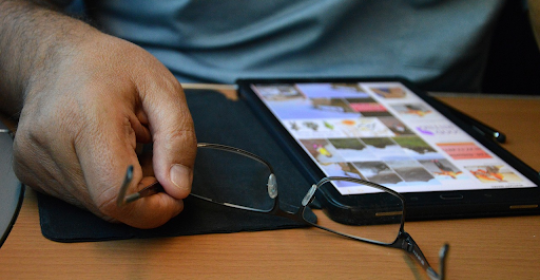This article will give you some employee onboarding ideas that will help you make the process more fun and relaxing, delighting your new colleagues and minimizing the stress of the first day.
8 employee onboarding ideas your new hires will love
Did you know that 80% of new employees who receive a poor onboarding plan to quit? Here’s a short list of ideas to prevent this and make the onboarding process much more fun and effective:
Office scavenger hunt
Yes, the scavenger hunt game is something children play, but that is exactly why you should incorporate it in your office – adults in suits playing it will make it look even more silly, relaxing the tension.
An office scavenger hunt can include questions such as "Find the marketing team leader's desk, introduce yourself, and ask them for a copy of the quarterly content schedule," which will also serve as a part of onboarding. That way, new employees will learn how things are going around the office, get to know new colleagues, and take on their first assignments.
Gamification
Adding game-like activities into your business environment shouldn't only be reserved for onboarding but can be helpful in any employee training.
For onboarding, get-to-know games work great, as they will let new teammates find out (important) stuff about each other and the organizational structure fast. Here are some excellent games to try:
- Two truths and a lie: Each employee should state three sentences about themselves, while others guess which is a lie. The person that guesses correctly is the next one to talk about themselves.
- Personality tests: While personality tests will give you valuable insights about new colleagues, you can make them fun too. For example, you can create a "What type of colleague are you" test where each answer is a person from "The Office" show.
- Ten things in common: Employees often play this game at team building activities, but it is also a good option for onboarding. Split all people into pairs and have them find ten things they have in common.
- Trivia and quizzes: Universal games can be a part of onboarding too. But you can make it even more creative. Create a list of fun questions related to office life and put them around in envelopes, like Easter eggs – at the coffee machine, watercooler, or in the cupboard. As new colleagues start getting used to the environment, they will find the questions and gradually collect answers.
Welcome kit
Creating employee welcome kits is simply a nice thing to do. Even something as simple as buying snacks for your new colleague will make their day more special and less stressful. But you can take it a step further and make it even more creative:
- Company merch: Cups, T-shirts, calendars, pens with company logos, all of those will make them feel like a part of the team.
- Tech gadgets: If you have the budget, giving them a gadget like noise-canceling headphones will be exceptionally nice, especially if you work in an open-space environment. But even cheap earbuds will work, and so will power banks, wireless phone chargers, and similar. These are good for any environment but, naturally, the best for tech firms and startups.
- Office table plants: Getting a lovely cup plant for your colleague's desk is a good idea as they purify the air, reduce stress, and look nice.
- Water bottle: Fancy heat-resistant water bottles are super helpful and something your new colleagues can use outside the office too.
- Beer: Who doesn't like a beer-tasting box?!
Onboarding buddy
Assigning an onboarding buddy for each new colleague will make their introduction much easier, which is one of the best practices for effective onboarding.
Whenever they need some help, their onboarding buddy will jump in. Plus, during the first day(s), they can even follow their more experienced colleague around and see how the usual workflow looks, so they have a better idea of where their place in the work chain is.
Consider creating a personalized employee onboarding experience by incorporating storytelling elements. Encourage new hires to make a digital scrapbook capturing their first days, interactions, and learnings. This creative approach not only personalizes the onboarding journey but also blends seamlessly with team introductions and initial trainings, fostering both engagement and connection. Besides being an enjoyable activity, scrapbooking digitally gives new employees the ability to revisit these memories anytime.
Employee feedback
Peer feedback is a super-valuable tool that will give employees insights into what others think about them. While feedback loops are something you should use in general, they also have their place during onboarding.
During peer training, new employees will cooperate with more experienced colleagues, simultaneously learning while building team chemistry. They can instantaneously get information about their process, resulting in improved results and quicker learning.
If you have a longer onboarding period, you can use peer evaluation at the end of it to encourage new employees going forward. Ensure you focus primarily on the positives when asking questions, as you don't want to be too harsh towards someone who just got there.
Using an employee feedback tool such as Effy to do this digitally is a good choice – it will let employees answer questions at their convenience and when they have time without disrupting their workflow with formalities.
Team outing
No matter how casual, the office is where work gets done. Therefore, taking your team outside to do something fun will let everyone relax and show their true self. Then you will have months to talk about who got drunk the most.
Jokes aside, fun, team-oriented activities such as adventure parks, paintball/airsoft, and rafting work best as everyone gets involved. Those will build team spirit and cooperation, and you will have a memorable photo to hang in the office lobby.
Decorating and gifts greeting
We have mentioned welcome kits, but general WELCOME ABOARD decoration and small gifts are also great options. That will show that all of the more experienced teammates know how it feels to be a rookie – no matter how good they are now, they have all been there at some point.
Creative employee handbook
While you should have an updated knowledge base team members can use at any time, coming up with a creative employee handbook is not just a nice thing to do but will speed up the onboarding process.
This handbook should contain the most critical FAQs a newcomer will likely have. These could be:
- Some brief details about their role
- Their supervisor's and teammates' names
- Around-the-office information
Anything from dress codes to company celebrations, team buildings, off-days, and birthday policies, should be there.
If you are unsure how to do it right, start by collecting questions employees frequently ask along the way – if more people ask the same question, something is probably unclear. Those questions will be the perfect material for onboarding new colleagues in the future.
Conclusion
We hope our article gave you ideas to help you create a winning onboarding strategy that will delight new colleagues and make their experience memorable.
If you are creative, you can make the entire onboarding experience much more effective and enjoyable. Building a leadership culture that involves everyone, not just the HR department, will have a tremendously positive impact on the company as a whole, paying dividends in increased employee job satisfaction, and reduced churn in the long run.






